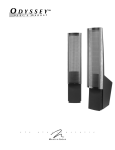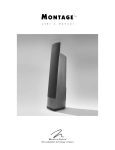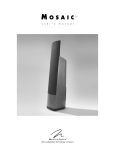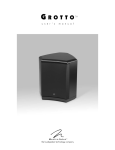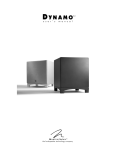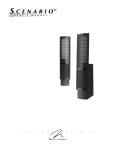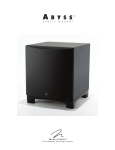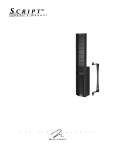Download MartinLogan E2 Home Theater System User Manual
Transcript
STATEMENT s e t u p m a n u a l TM E2 MA R T I N LOGA N® the loudspeaker technology company CONTENTS Contents . . . . . . . . . . . . . . . . . . . . . . . . . . . . . . . . . . . . .2 Before You Begin . . . . . . . . . . . . . . . . . . . . . . . . . . . . . .3 Master Packing List Required Tools Unpacking the Statement e2 Speaker Placement . . . . . . . . . . . . . . . . . . . . . . . . . . . .4 Initial Speaker Placement The Wall Behind the Listener The Wall Behind the Speakers The Side Walls Assembly . . . . . . . . . . . . . . . . . . . . . . . . . . . . . . . . . . . . .5 Subwoofer Tower Assembly Transition/ESL Tower Assembly . . . . . . . . . . . . . . . . . .10 Connections—Exos Crossover Inputs . . . . . . . . . . . .21 Connections—Exos Crossover Outputs . . . . . . . . . .22 Subwoofer Outputs Full Range Outputs 2 Contents Connections—ESL/Transition Towers . . . . . . . . . . . .23 Bi-Wire Connection Horizontal Passive Bi-Amplification Vertical Passive Bi-Amplification . . . . . . . . . . . . . . . . .24 Connections—Subwoofer Towers . . . . . . . . . . . . . . .25 8-Ohm Connection 2-Ohm Connection 4-Ohm Bi-Amp Connection Passive Hi-Pass Settings . . . . . . . . . . . . . . . . . . . . . . .26 The High-Pass Settings AC Power Connection . . . . . . . . . . . . . . . . . . . . . . . . .28 Making It Work Together . . . . . . . . . . . . . . . . . . . . . .29 Making It Work Together (Part 1) Subwoofer Level Knob Setting the Dip Switches Making It Work Together (Part 2) . . . . . . . . . . . . . . . . .30 Speaker Placement (Fine Tuning) . . . . . . . . . . . . . . . .31 Hard Sound Tweaking the Room BEFORE YOU BEGIN Master Packing List Before you being setting up the Statement e2, please make sure that all 15 crates/boxes are present and accounted for. The list below gives a detailed description of what can be found in each numbered crate/box. # Contents Sub (Left) 1 Master Sub, Left 2 Middle Sub, Left 3 Middle Sub, Left 4 Top Sub, Left Sub (Right) 5 Master Sub, Right 6 Middle Sub, Right 7 Middle Sub, Right 8 Top Sub, Right ESL/Transition Towers 9 Trim & Sub Harness x 2 10 ESL Towers x 2 11 Transition Towers x 2 12 Instruction Box (Hardware, tools, etc.) Base (Left) 13 Base Assembly, Left Base (Right) 14 Bass Assembly, Right EXOS 15 EXOS Electronic Crossover Required Tools Provided (in crate 12): —9/16” Socket —7/32” Hex head —Ratcheting screwdriver —Grill cloth tool You will need to provide: —#2 Phillips head screwdriver —Small standard screwdriver —Level —Cordless drill with a #2 phillips head bit Not required, but useful: —1/ 4” Drive ratchet with extension —1/ 4” Open end wrench —Cotton gloves Unpacking the Statement E2 WARNING! Unpacking the Statement Evolution 2 electrostatic speaker system requires a minimum of two people. Do not attempt any part of the unpacking process with one person. 1 Using a power drill and a #2 Phillips head drill bit, remove the screws from the tops of all crates. Remove the top of each crate and set it aside, preferably in another room. 2 Unpack the contents of the 4 left sub crates near the front left corner of the room. Remove the crates from the room. 3 Unpack the contents of the 4 right sub crates near the front right corner of the room. Remove the crates from the room. 4 Unpack the contents of the 4 ESL/Transition tower crates in an out of the way spot in the room. Remove the crates from the room. 5 Unpack the contents of the left base crate near the left side of the room approximately 7 feet from the front wall. Remove the crates from the room. 6 Unpack the contents of the right base crate near the right side of the room approximately 7 feet from the front wall. Remove the crates from the room. Before You Begin 3 SPEAKER PLACEMENT Initial Speaker Placement For optimal performance of the Statement e2 system we recommend that the ESL/Transition towers be placed approximately five to seven feet from the front wall (the wall in front of the listening position) and at least two feet from the side walls. The subwoofer towers should be placed diagonally (or against a wall) in the front corners of the room with at least one foot of clearance between the woofers and the walls. The listening position should be farther than the distance between the speakers themselves. What you are trying to attain is the impression of good center imaging and stage width (see figure 1). There is no exact distance between speakers and listener, but there is a relationship. In long rooms, naturally, that relationship changes. The distance between the speakers will be far less than the distance from you to the speaker system. However, in a wide room, you will still find that if the distance from the listener to the speakers becomes smaller than the distance between the speakers themselves, the image will no longer focus in the center. The Wall Behind the Listener Near-field reflections can occur from your back wall, the wall behind the listening position. If your listening position is close to the back wall, these reflections can cause problems and confuse the quality of imaging. Actually it is better for the wall behind you to be soft rather than bright. If you have a hard back wall and your listening position is close to it, experiment with devices that will soften and absorb information (i.e., wall hangings and possibly even sound absorbing panels). The Wall Behind the Speakers The front surface, the wall behind your speakers, should not be extremely hard or soft. For instance, a pane of glass will cause reflections, brightness and confused imaging. Curtains, drapery and objects such as bookshelves can be placed along the wall to soften a hard surface. A standard sheet rock or textured wall is generally an adequate surface if the rest of the room is not too bright and hard. Sometimes walls can be too soft. If the entire front wall consists of only heavy drapery, your system can sound too soft or dull. You may hear dull, muted music with little ambience. Harder room surfaces will actually help in this case. The front surface should, optimally, be one long wall without any doors or openings. If you have openings, the reflection and bass characteristics from one channel to the other can be different. The Side Walls The same requirements exist for side walls. Additionally, a good rule of thumb is to have the side walls as far away from the speaker sides as possible, minimizing near-field side wall reflections. Sometimes, if the system is bright or the imaging is not to your liking, and the side walls are very near, try putting curtains or softening material directly to the edge of each speaker. An ideal side wall, however, is no side wall at all. Figure 1. Initial Speaker Placement. 4 Speaker Placement ASSEMBLY Subwoofer Tower Assembly WARNING! Assembling the Statement e2 requires two people, except for step 12 of the subwoofer tower assembly, which requires three people. Do not attempt any part of the assembly process with one person. 1 2 Place the primary subwoofer module in position on the floor, (the primary module has 10 binding posts). Corner placement is recommended—it is important to place the sub towers as close to final position as possible, as the final assembled tower weighs approximately 500 lb. However, for assembly you must leave enough space to have access to all sides of the sub tower. Place a level in position as shown to level the module left to right. Adjust the glider pads on the bottom of the cabinet to achieve level. Figure 2 Position the level as shown to level the primary module front to back, adjusting the glider pads on the bottom of the cabinet to achieve level. Figure 3 3 Pick up a secondary module with an assembler on each end and place carefully onto the primary module by lining up the cone feet on the secondary with the indentations at each corner of the primary module. Use your index finger as shown to feel when the cone feet are in position. Figure 4 Assembly 5 4 After the second module is in position atop the primary module, place a level on it as shown. Level the module front to back by inserting a small allen wrench (or other suitable instrument) through the hole in the cones on the base of the module (detail), and rotating the cone up or down to achieve level. 5 Level the module left to right with the level in position as shown. Adjust the cone feet for height. 6 Once the secondary module is level, install the stainless steel Martin-Logan logo plates. You have a choice of using either a blue or red backing behind the logo— the vinyl insert is two-sided. Peel the protective plastic from the insert and position the insert between the logo plate and line up with the mounting holes on the top and bottom of the sub modules as shown. Insert the 3/8”-16 x 1” button head cap screws—do not tighten until all 4 screws are started, and then tighten in a cross-pattern so that all screws tighten down together. Use a 7/ 32” allen wrench. Figure 5 Figure 6 Figure 7 6 Assembly 7 Stack the next secondary module atop the second utilizing the same assembly procedure used in step 3. Figure 8 8 Align the cones to the indentations on the cabinet below, and level the module front-to-back and left-toright, following the same procedure used in steps 4 and 5. Figure 9 9 Repeat the procedure in step 6. Figure 10 Assembly 7 10 Place the fourth and final module in position (repeating steps 3 thru 6). The top module is distinguished from the other modules by the lack of mounting holes on the top bracket (as shown). Figure 11 11 Align the slots on the top and bottom of the grill cloth frames with the curved extrusion on the module. Place firmly into position so that the velcro fasteners are securely meshed. Figure 12 8 Assembly 12 Install woofer wiring harness as shown. You can move the tower to the preferred listening position by shifting the unit from side to side and “walking” it. Figure 13 13 When you are confident the sub tower is correctly positioned, mark the floor with masking tape at each corner. Install the spikes by using a safe dolly to tip the sub tower back, remove the glides, and then screw the spikes into place. Make sure you thread the large black rubber washer onto the spike post before installing in the tower. Place the tower in a vertical position, and level front to back by tilting the tower back (at least 3 people are required) and adjusting the spikes. Figure 14 Assembly 9 Transition/Electrostatic Tower Assembly Note: The following instructions describe the assembly of the right channel high-and mid-frequency tower. Duplicate all assembly instructions for the left tower assembly. 1 Attach the outside (semi-circle shaped) trim rail to the transition tower by aligning the five pins on the trim rail with the 5 cam holes in the tower. 2 Use a phillips head screwdriver to rotate the cams a little over 180° counter clockwise once the pin is properly aligned in the cam. The arrow on the cam must be in the position shown to accept the pin. 3 Make sure the trim rail is flush with the tower edge. Figure 15 Figure 16 Figure 17 10 Assembly 4 Install the inside wing (wedge shaped with pins on the side) trim rail by aligning the 5 pins with the corresponding cams as in the previous assembly, only this time the cams turn clockwise to lock in the trim wing. Figure 18 5 Finished transition tower assembly. Figure 19 Assembly 11 6 Pick up the transition tower assembly and insert it as shown into the base so the three holes in the mounting bracket line up with the holes in the tower. 7 Push the tower towards the center for proper alignment. 8 Once the holes are properly aligned, insert the 31/2” x 9/16” hex head lag screws through a steel washer and into the tower. Finger tighten—do not tighten all the way. Figure 20 Figure 21 Figure 22 12 Assembly 9 Use a level to bring the tower 90 degrees vertical left to right. Figure 23 10 When the tower is perfectly plumb, go ahead and tighten the bolts securely. Figure 24 11 Use your level to plumb the tower front to back. Figure 25 Assembly 13 12 Tighten tower wing bolt. Figure 26 13 Tighten base bolts. Figure 27 14 Connect the tower as shown (red to red, black to black). Figure 28 14 Assembly 15 Install the ESL wing trim (wedge shaped with pins on the narrow end) by aligning the 5 pins with the corresponding cams. The cams turn clockwise to lock the trim with in place. Figure 29 16 Insert the electrostatic panel as shown. Figure 30 17 Line up holes and insert the 21/4” x 9/16” button head cap screws (black) through a steel washer and into the tower. Finger tighten. Figure 31 Assembly 15 18 Use a level to plumb the electrostatic panel left-toright. Figure 32 19 Measure the space between towers (top and bottom). The space should measure exactly 2 inches. Figure 33 20 Tighten frame bolts as shown. Figure 34 16 Assembly 21 Use a level to plumb the electrostatic panel front-toback. Figure 35 22 Tighten wing bolts. Figure 36 23 Tighten base bolts. Figure 37 Assembly 17 24 Connect light bar Figure 38 25 Connect electrostatic panel wires to the color-coded screw-terminal connector. Figure 39 26 ESL panel properly connected. Figure 40 18 Assembly 27 Find the loops at the top of the transition tower grill sock. Figure 41 28 Hook the loops as indicated at the top of the tower. Figure 42 29 Hook the loops on the bottom of the sock on the bottom of the tower as indicated. Figure 43 Assembly 19 30 Push the grill sock into the slot provided to stretch the cloth taut, from top to bottom. Figure 44 31 Place the top of the base into position. Note: You may want to wait before installing the top of the base as settings inside the base may need changing. Figure 45 20 Assembly CONNECTIONS—EXOS CROSSOVER INPUTS Connect the outputs of the Preamplifier/Processor to the inputs of the EXOS using either balanced or single ended connections. There are right channel, left channel and optional 0.1 effects channel inputs. WARNING! Use either all balanced or all single ended connections for signal inputs. Do not use both. Figure 46. EXOS signal inputs. Balanced connection shown. Connections—Exos Crossover Inputs 21 CONNECTIONS—EXOS CROSSOVER OUTPUTS Subwoofer Outputs Connect the EXOS subwoofer outputs to the amplifier(s) for the woofer towers using either balanced or single ended connections. Both the balanced and single ended outputs are always on—you can use either option to connect the woofer tower amplifier(s) regardless of which you used for signal input. EXOS E 2 Note: Use either all balanced or all single ended connections for subwoofer outputs. Do not use both. Figure 47. EXOS outputs. Balanced connections shown. 22 Connections—Exos Crossover Outputs Full Range Outputs Connect the full range outputs of the EXOS to the amplifier(s) for the ESL/Transition tower using the same type of connection used for the signal inputs. Note: The full range outputs should use the same connectors as the signal inputs. They are directly connected together. CONNECTIONS—ESL/TRANSITION TOWERS Bi-Wire Connection This method of connection uses individual runs of speaker wire from your amplifier. This doubles the signal carrying conductors from the amplifier to the speaker, thus directcoupling each portion of the crossover to the amplifier. Connect one set of wires to the upper set of binding posts which connect to the ESL panel of the Statement e2. Then connect a second set of wires to the lower binding posts which connect to the transitions tower. Next, connect both sets of wires to the appropriate terminals on your amplifier. Please take care to connect both (+) wires to the (+) amplifier terminals and both (-) wires to the (-) amplifier terminals. This is known as a parallel connection (See Figure 48). Figure 48. Bi-wire connection. One Channel shown. Horizontal Passive Bi-Amplification Horizontal bi-amping allows you to use two different types, models or brands of amplifiers (i.e. tubes on top, transistor on the bottom). However, we recommend that you use two identical amplifiers (i.e. same brand and model). If you must use two different amplifiers, it is essential that they have the same gain or that one of the two have adjustable gain so that you can match their gain characteristics. If the amplifiers of choice do not have the same gain characteristics, then a sonic imbalance will occur. With horizontal bi-amping, one amplifier drives the high pass (ESL) section while the second amplifier drives the low pass (WOOFER) section. Connect the low frequency amplifier to the lower set of binding posts of both speakers. Connect the high frequency amplifier to the upper set of binding posts (see figure 49). Figure 49. Horizontal passive bi-amplification. One Channel shown. Connections—ESL/Transition Towers 23 Vertical Passive Bi-Amplification The very nature of vertical bi-amping dictates that both amplifiers be identical. With vertical bi-amping, each of the stereo amplifiers is dedicated to one speaker. For instance, the left channel of each amplifier drives the low pass (Transition) section while the right channel drives the high pass (ESL) section. Starting with one speaker, connect the right channel to the lower binding posts and the left channel to the upper binding posts. Repeat the same procedure for the other speaker. Connect the left preamplifier outputs to both inputs of the left channel amplifier and the right preamplifier outputs to both inputs of the right channel speaker (See Figure 50). Figure 50. Vertical passive bi-amplification. One Channel shown. 24 Connections—ESL/Transition Towers CONNECTIONS—SUBWOOFER TOWERS 8-Ohm Connection 4-Ohm/Bi-Amp Connection This connection method is safe for all amplifiers (see figure 51). Use this connection method if you wish to use two amplifiers to drive the subwoofer towers (see figure 53). 2-Ohm Connection This connection is the loudest, but draws the most power from the amplifier (see figure 52). If using this connection method, make sure your amp can handle 2-Ohms. Figure 51. 8-Ohm configuration. One channel shown. Figure 52. 2-Ohm configuration. One channel shown. Figure 53. 4-Ohm/bi-amp configuration. One channel shown. Connections—Subwoofer Towers 25 PASSIVE HIGH-PASS SETTINGS The High-Pass Settings The passive high-pass settings can be adjusted by changing the red and black jumpers found in the high-pass section of the ESL/Transition tower passive crossover. WARNING! Before changing the passive-high pass options be sure to turn the amps off and unplug the Statement e2 ESL/Transition tower. The design of these jumpers accommodates different listening distances to the speaker (distance between listener and speaker). The unit is shipped in 15ft mode. If the user is only 10-feet away the jumpers need to be changed. The jumpers are located near the side of the crossover located in the ESL/Transition tower bases (see figure 54). There are red and black jumpers that are either connected or not connected through the screw terminal block (see figure 56 & 57). WARNING! Never connect the red wires to the black. wires. Figure 54. The location of the passive high-pass jumpers 26 Passive High-Pass Settings The 4 options are (from least output to most output): 10-Foot Mode (figure 58) —Red not connected and black connected. —0dB All-Closed Mode (figure 59) —Red connected and black connected —200Hz–300Hz +1dB All-Open Mode (figure 60) — Red not connected and black not connected —3dB peak at 300Hz 15-Foot Mode (default—(figure 61) —Red connected and black not connected —200Hz–300Hz +1dB —3dB peak at 300Hz Figure 55 demonstrates how these different settings effect the frequency response. Note: — The ten-foot mode has been set to 0db. — The all-closed setting raises the output from 200Hz to 700Hz by 1db — The all-open setting adds a peak of 3db around 300Hz — The 15-foot mode adds both of the above changes Figure 55. The effects of the four jumper setting on frequency response relative to 10-foot mode. Figure 56. Open (not connected) jumpers. Figure 57. Closed (connected) jumpers. Figure 58. Jumper settings for 10-foot mode. Figure 59. Jumper settings for all-closed mode. Figure 60. Jumper settings for all-open mode. Figure 61. Jumper settings for 15-foot mode. Passive High-Pass Settings 27 AC POWER CONNECTIONS Because your MartinLogan Statement e2 ESL/Transition towers use an internal power supply to energize their electrostatic cells with high-voltage DC, they must be connected to an AC power source. The EXOS crossover must also be connected to an AC power source. For this reason the proper IEC standard power cords are provided. These cords should be firmly inserted into the AC power receptacles on the rear connection panel of the speakers and the EXOS, then to any convenient AC wall outlet. The ESL/Transition towers integrate a signal sensing power supply which will switch off after a few minutes of no music signal, and requires less than two seconds to recharge the panels when a music signal is present. Your Statement e2 speakers and EXOS crossover are wired for the power service supplied in the country of original consumer sale. The AC power rating applicable to a particular unit is specified both on the packing carton and on the serial number plate attached to the speaker. WARNING! Turn all amplifiers off when plugging in or unplugging the EXOS. WARNING! The power cord should not be installed, removed, or left detached from the speaker while the other end is connected to an AC power source. Figure 62. EXOS E2.5 IEC power cord AC receptacle. 28 AC Power Connections If you remove your Statement e2 speakers and EXOS crossover from the country of original sale, be certain that AC power supplied in any subsequent location is suitable before connecting and operating the speakers. Substantially impaired performance or severe damage may occur to a speaker if operation is attempted from an incorrect AC power source. Figure 63. Statement E2 IEC power cord AC receptacle. MAKING IT WORK TOGETHER Making It Work Together (Part 1) Setting the Dip Switches Now that you know all the connection options and how to set them, it’s time to make the speakers work in their target environment. For this part, it is recommended that an audio analyzer be used (RTA or a computer based instrument). This should only be done by a qualified technician. Start with default settings. Look at the 200Hz to 500Hz area of the ESL-transition tower alone. If there is too much energy in this area, try changing the jumpers in the passive high-pass accordingly (see page 26). There are three controls that can be set by the dip switches located inside the EXOS (see figure 65): — 25Hz Level (–8,–4,0,+4,+8)dB — 50Hz Level (–8,–4,0,+4,+8)dB — Phase Adjustment (0°, 90°, 180°, 270°) Note how low the transition tower is playing. The transition tower is somewhat dependent on back wall reflections for its low frequency extension. If it is set right it should respond well down to 60HZ. If it does not play to 60Hz, the speaker is either to close or to far from the back wall. If the speaker is over 7 feet from the wall, try moving it back. If it is under 5 feet, try moving it out. Side wall distance can effect this as well. Some experimentation may be in order. Subwoofer Level Knob Note: Sonic measuring equipment is highly recommended for this part of the setup. How to adjust the dip switches: 1 Turn off all amplifiers connected to the EXOS. 2 Unplug the unit. 3 Remove the lid. 4 If more output is desired at 25Hz flip the +4dB or the +8dB dip switches to on. If less bass is desired at 25Hz flip the –4dB or the –8dB dip switches to on. Setting the level too high will cause the bass to seem bloated and is the single most common cause of bad sounding subwoofers. A rule of thumb is that the subwoofer should not draw attention to itself, but should simply make the systems low end seem more extended and accurate. Figure 64. The Exos E2.5 subwoofer level knob. Figure 65. The exos six dip switch clusters. All set in their default position. Making It Work Together 29 Making It All Work Together (Part 2) You will need to set the dip switches for both right and left channel. Note: Only one dip switch per dip switch cluster should be on at a time. Note: This unit will generate electrical transients on its outputs when the power is turned off or on. This can cause loud noises if the amplifiers are turned on. 5 If available, use test equipment to optimize the subwoofer response. 6 The 50Hz control works the same as the 25Hz control. 7 The phase settings allow the phase of the woofer section to be modified in the crossover area. This allows for a phase match between the ESL/transition-tower and the subwoofer. The phase dip switch should be set to 270° to start. We have found this setting to work well in most situations. To adjust the phase see figure four. Turn on both the woofer and ESL/transition-tower. Try turning the woofer level up and down on the EXOS. This will allow you to see how the crossover is meeting. If you turn the woofer up and a suck-out appears at the crossover frequency the phase switch on the EXOS needs to be adjusted. 8 Replace the lid. 9 Plug the unit in. Adjusting the phase switch is best accomplished by trying different settings with the amplitude of the woofer output matching that of the ESL. Find the setting that creates the biggest suck-out at the crossover point. Now flip the switches to 180° from that position. Almost always the 270° default position is the best. 10 Turn the amplifier on. Figure 66. The five setting options for the 25Hz and 50Hz dip switches 30 Making It Work Together Figure 67. The four setting positions for the phase dip switches. Speaker Placement (Fine Tuning) Toe in the ESL/Transition towers so the listener is looking at the inner 1/ 3 of the ESL panels. Sitting at the listening position, hold a flashlight under your chin and point it at each speaker. The reflection of the flashlight should be 1/ 3 of the way out from the inner edge of the panel (see figure 68). Viewed from the listening position, the 2-inch space between the transition tower and ESL frame should appear the same on both channels (see figure 66). When you are happy with the final placement of the ESL/Transition towers, carefully remove the glider feet and install the ETC spikes. Hard Sound If the speaker sounds hard, there are two options: 1 Change the jumpers on the passive high-pass to turn up the lower midrange (see page 26). 2 Try tilting the speaker back (raise the front feet of the unit). The listener should be straight on with the bottom 1/ 3 of the panel when listening. Figure 68. Ideal placement of the ESL/Transition towers. Tweaking the Room When you are finished setting up the Statement e2, you should turn the unit up very loud and check the room for rattles. If any are found they should be eliminated. ESL Tower Spike Installation When you are happy with the placement of the ESL/ transition towers, we recommend that you install the ETC spikes. This procedure requires at least two people—one to tip the tower and one to install the spikes. 1 With one person standing behind the tower carefully tip the tower back. 2 Remove the glider feet and the screw the 2 front spikes into place making sure to thread the large black rubber washer onto the spike post. 3 With one person standing in front of the tower carefully tip the tower forward. 4 Remove the remaining glider foot and the screw the back spikes into place making sure to thread the large black rubber washer onto the spike post. Figure 69. Statement spikes. Making It Work Together 31 MA R T I N LOGA N® the loudspeaker technology company 2101 Delaware Street, Lawrence, Kansas 66046, USA tel 785.749.0133 fax 785.749.5320 www.martinlogan.com ©2003 MartinLogan, All rights reserved Rev. #100203
































